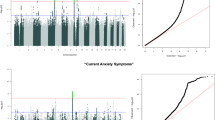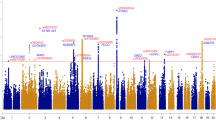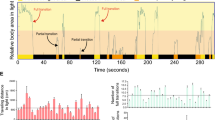Abstract
Several linkage studies on anxiety have been carried out in samples ascertained through probands with panic disorder. The results indicated that using a broad anxiety phenotype instead of a DSM-IV anxiety disorder diagnosis might enhance the chance of finding a linkage signal. In the current study, a genome-wide linkage analysis was performed on anxiety measured with a self-report questionnaire whose scores are highly correlated with DSM-IV anxiety disorders. The self-report questionnaire was included in five surveys of a longitudinal study of the Netherlands Twin Register. Genotype and phenotype data were available for 1602 twins and siblings. To estimate identity by descent , additional genotype data for 564 parents and 22 siblings were used. Linkage analyses were carried out using MERLIN-regress on the average anxiety scores across time. A linkage signal (logarithm of odds score 3.4, empirical P-value 0.07) was obtained at chromosome 14 for marker D14S65 at 105 cM (90% confidence interval, 99–115 cM bounded by markers D14S1434 and D14S985). This finding replicates a linkage finding for a broad anxiety phenotype in a clinically based sample, indicating that the region might harbor a quantitative trait locus associated with the whole spectrum of general anxiety, that is from the normal to the clinical range. Moreover, genome-wide linkage and association studies on emotionality in mice obtained significant results in a syntenic region on mouse chromosome 12. Two homolog genes lie in this region –Dlk1 (delta-like 1 homolog, Drosophila) and Rtl1 (retrotransposon-like 1). Future association studies of these genes are warranted.
This is a preview of subscription content, access via your institution
Access options
Subscribe to this journal
Receive 12 print issues and online access
$259.00 per year
only $21.58 per issue
Buy this article
- Purchase on Springer Link
- Instant access to full article PDF
Prices may be subject to local taxes which are calculated during checkout


Similar content being viewed by others
References
Bijl RV, Ravelli A, van Zessen G . Prevalence of psychiatric disorder in the general population: results of The Netherlands Mental Health Survey and Incidence Study (NEMESIS). Soc Psychiatry Psychiatr Epidemiol 1998; 33: 587–595.
Kessler RC, Berglund P, Demler O, Jin R, Merikangas KR, Walters EE . Lifetime prevalence and age-of-onset distributions of DSM-IV disorders in the National Comorbidity Survey Replication. Arch Gen Psychiatry 2005; 62: 593–602.
Hettema JM, Neale MC, Kendler KS . A review and meta-analysis of the genetic epidemiology of anxiety disorders. Am J Psychiatry 2001; 158: 1568–1578.
Hettema JM, Prescott CA, Myers JM, Neale MC, Kendler KS . The structure of genetic and environmental risk factors for anxiety disorders in men and women. Arch Gen Psychiatry 2005; 62: 182–189.
Middeldorp CM, Birley AJ, Cath DC, Gillespie NA, Willemsen G, Statham DJ et al. Familial clustering of major depression and anxiety disorders in Australian and Dutch twins and siblings. Twin Res Hum Genet 2005; 8: 609–615.
Crowe RR, Goedken R, Samuelson S, Wilson R, Nelson J, Noyes Jr R . Genomewide survey of panic disorder. Am J Med Genet 2001; 105: 105–109.
Fyer AJ, Hamilton SP, Durner M, Haghighi F, Heiman GA, Costa R et al. A third-pass genome scan in panic disorder: evidence for multiple susceptibility loci. Biol Psychiatry 2006; 60: 388–401.
Gelernter J, Bonvicini K, Page G, Woods SW, Goddard AW, Kruger S et al. Linkage genome scan for loci predisposing to panic disorder or agoraphobia. Am J Med Genet 2001; 105: 548–557.
Gelernter J, Page GP, Bonvicini K, Woods SW, Pauls DL, Kruger S . A chromosome 14 risk locus for simple phobia: results from a genomewide linkage scan. Mol Psychiatry 2003; 8: 71–82.
Gelernter J, Page GP, Stein MB, Woods SW . Genome-wide linkage scan for loci predisposing to social phobia: evidence for a chromosome 16 risk locus. Am J Psychiatry 2004; 161: 59–66.
Hamilton SP, Fyer AJ, Durner M, Heiman GA, Baisre dL, Hodge SE et al. Further genetic evidence for a panic disorder syndrome mapping to chromosome 13q. Proc Natl Acad Sci USA 2003; 100: 2550–2555.
Kaabi B, Gelernter J, Woods SW, Goddard A, Page GP, Elston RC . Genome scan for loci predisposing to anxiety disorders using a novel multivariate approach: strong evidence for a chromosome 4 risk locus. Am J Hum Genet 2006; 78: 543–553.
Knowles JA, Fyer AJ, Vieland VJ, Weissman MM, Hodge SE, Heiman GA et al. Results of a genome-wide genetic screen for panic disorder. Am J Med Genet 1998; 81: 139–147.
Smoller JW, Acierno Jr JS, Rosenbaum JF, Biederman J, Pollack MH, Meminger S et al. Targeted genome screen of panic disorder and anxiety disorder proneness using homology to murine QTL regions. Am J Med Genet 2001; 105: 195–206.
Weissman MM, Fyer AJ, Haghighi F, Heiman G, Deng Z, Hen R et al. Potential panic disorder syndrome: clinical and genetic linkage evidence. Am J Med Genet 2000; 96: 24–35.
Thorgeirsson TE, Oskarsson H, Desnica N, Kostic JP, Stefansson JG, Kolbeinsson H et al. Anxiety with panic disorder linked to chromosome 9q in Iceland. Am J Hum Genet 2003; 72: 1221–1230.
Middeldorp CM, Cath DC, van Dyck R, Boomsma DI . The co-morbidity of anxiety and depression in the perspective of genetic epidemiology. A review of twin and family studies. Psychol Med 2005; 35: 611–624.
Spielberger CD, Gorsuch RL, Lushene RE . STAI Manual for the State-Trait Anxiety Inventory. Consulting Psychologists Press: Palo Alto, CA, 1970.
Van der Ploeg H, Defares PB, Spielberger CD . Zelfbeoordelingsvragenslijst STAI, versie DY-1 en DY-2. Swets & Zeitlinger: Lisse, 1979.
American Psychiatric Association. Diagnostic and Statistical Manual of Mental Disorders, 4th edn. APA: Washington, DC, 1994.
Middeldorp CM, Cath DC, van den Berg M, Beem AL, van Dyck R, Boomsma DI . The association of personality with anxious and depressive psychopathology. In: Canli T (ed). The Biological Basis of Personality and Individual Differences. Guilford Press: New York, 2006, pp 251–272.
Boomsma DI, Vink JM, Van Beijsterveldt TC, de Geus EJ, Beem AL, Mulder EJ et al. Netherlands Twin Register: a focus on longitudinal research. Twin Res 2002; 5: 401–406.
Boomsma DI, Beem AL, van den Berg M, Dolan CV, Koopmans JR, Vink JM et al. Netherlands twin family study of anxious depression (NETSAD). Twin Res 2000; 3: 323–334.
World Health Organization. Composite International Diagnostic Interview (version 2.1). WHO: Geneva, 1992.
Eysenck HJ, Eysenck SBG . Eysenck Personality Inventory. Educational Industrial Testing Service: San Diego, CA, 1964.
Wilde GJS . Neurotische labiliteit gemeten volgens de vragenlijstmethode (The Questionnaire Method as a Means of Measuring Neurotic Instability). Van Rossen: Amsterdam, 1970.
Achenbach TM . The Young Adult Self Report., Deptartment of Psychiatry, University of Vermont: Burlington, VT, 1990.
Beck AT, Rial WY, Rickels K . Short form of depression inventory: cross-validation. Psychol Rep 1974; 34: 1184–1186.
Verhulst FC, Ende Jv, Koot HM . Handleiding voor de Youth Self Report. Afdeling Kinder- en Jeugdpsychiatrie, Sophia Kinderziekenhuis/Academisch Ziekenhuis Rotterdam/Erasmus Universiteit Rotterdam: Rotterdam, 1997.
Meulenbelt I, Droog S, Trommelen GJ, Boomsma DI, Slagboom PE . High-yield noninvasive human genomic DNA isolation method for genetic studies in geographically dispersed families and populations. Am J Hum Genet 1995; 57: 1252–1254.
Miller SA, Dykes DD, Polesky HF . A simple salting out procedure for extracting DNA from human nucleated cells. Nucleic Acids Res 1988; 16: 1215.
Abecasis GR, Cherny SS, Cookson WO, Cardon LR . GRR: graphical representation of relationship errors. Bioinformatics 2001; 17: 742–743.
Abecasis GR, Cherny SS, Cookson WO, Cardon LR . Merlin–rapid analysis of dense genetic maps using sparse gene flow trees. Nat Genet 2002; 30: 97–101.
Duffy DL . An integrated genetic map for linkage analysis. Behav Genet 2006; 36: 4–6.
Kong X, Murphy K, Raj T, He C, White PS, Matise TC . A combined linkage-physical map of the human genome. Am J Hum Genet 2004; 75: 1143–1148.
Sham PC, Purcell S, Cherny SS, Abecasis GR . Powerful regression-based quantitative-trait linkage analysis of general pedigrees. Am J Hum Genet 2002; 71: 238–253.
Haseman JK, Elston RC . The investigation of linkage between a quantitative trait and a marker locus. Behav Genet 1972; 2: 3–19.
Nash MW, Huezo-Diaz P, Williamson RJ, Sterne A, Purcell S, Hoda F et al. Genome-wide linkage analysis of a composite index of neuroticism and mood-related scales in extreme selected sibships. Hum Mol Genet 2004; 13: 2173–2182.
Sawcer S, Jones HB, Judge D, Visser F, Compston A, Goodfellow PN et al. Empirical genomewide significance levels established by whole genome simulations. Genet Epidemiol 1997; 14: 223–229.
Flint J, Corley R, DeFries JC, Fulker DW, Gray JA, Miller S et al. A simple genetic basis for a complex psychological trait in laboratory mice. Science 1995; 269: 1432–1435.
Plomin R, McClearn GE, Gora-Maslak G, Neiderhiser JM . Use of recombinant inbred strains to detect quantitative trait loci associated with behavior. Behav Genet 1991; 21: 99–116.
Solberg LC, Valdar W, Gauguier D, Nunez G, Taylor A, Burnett S et al. A protocol for high-throughput phenotyping, suitable for quantitative trait analysis in mice. Mamm Genome 2006; 17: 129–146.
Valdar W, Solberg LC, Gauguier D, Burnett S, Klenerman P, Cookson WO et al. Genome-wide genetic association of complex traits in heterogeneous stock mice. Nat Genet 2006; 38: 879–887.
Altenberger T, Bilban M, Auer M, Knosp E, Wolfsberger S, Gartner W et al. Identification of DLK1 variants in pituitary- and neuroendocrine tumors. Biochem Biophys Res Commun 2006; 340: 995–1005.
Yin D, Xie D, Sakajiri S, Miller CW, Zhu H, Popoviciu ML et al. DLK1: increased expression in gliomas and associated with oncogenic activities. Oncogene 2006; 25: 1852–1861.
Camp NJ, Cannon-Albright LA . Dissecting the genetic etiology of major depressive disorder using linkage analysis. Trends Mol Med 2005; 11: 138–144.
Fullerton J . New approaches to the genetic analysis of neuroticism and anxiety. Behav Genet 2006; 36: 147–161.
Acknowledgements
This study was supported by the Netherlands Organization for Scientific Research NWO/ZonMW (400-05-717, 911-03-016, 904-61-193, 985-10-002, 575-25-006), NIH R01 HL55976 and NHBLI Mammalian Genotyping Service (Marshfield). Statistical analyses were carried out on the Genetic Cluster Computer (http://www.geneticcluster.org), which is financially supported by the Netherlands Scientific Organization (NWO 480-05-003). CM was supported by the Hersenstichting Nederland (13F05(2).47).
Author information
Authors and Affiliations
Corresponding author
Rights and permissions
About this article
Cite this article
Middeldorp, C., Hottenga, JJ., Slagboom, P. et al. Linkage on chromosome 14 in a genome-wide linkage study of a broad anxiety phenotype. Mol Psychiatry 13, 84–89 (2008). https://doi.org/10.1038/sj.mp.4002061
Received:
Revised:
Accepted:
Published:
Issue Date:
DOI: https://doi.org/10.1038/sj.mp.4002061
Keywords
This article is cited by
-
Alteration of imprinted Dlk1-Dio3 miRNA cluster expression in the entorhinal cortex induced by maternal immune activation and adolescent cannabinoid exposure
Translational Psychiatry (2014)
-
Imprinted DLK1-DIO3 region of 14q32 defines a schizophrenia-associated miRNA signature in peripheral blood mononuclear cells
Molecular Psychiatry (2012)
-
Meta-analyses of genome-wide linkage scans of anxiety-related phenotypes
European Journal of Human Genetics (2012)
-
Hostility in adolescents and adults: a genome-wide association study of the Young Finns
Translational Psychiatry (2011)
-
TMEM132D, a new candidate for anxiety phenotypes: evidence from human and mouse studies
Molecular Psychiatry (2011)



